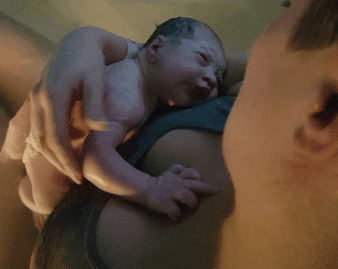Vanessa Manni
Midwife
wo**********@***il.com
@wombwisdom__
Summary
It is no secret in our society that labour and birth are painful. What we don’t talk about, though, is the value of the functions of the pain women feel throughout their experience of birth. Pain is very subjective, and the sensations felt during labour not only change from woman to woman but even from birth to birth for the same mother. Once we understand pain, we can then concentrate on how to deal with what we’re experiencing and how to find comfort.
The Purpose of Pain
When we start experiencing labour sensations, we usually pay attention to what is happening and take ourselves to an environment where we can feel safe and envision our births. We alert our birth partners to receive support and focus on what is about to happen. Pain keeps us safe.
How we experience painful sensations will guide us on how to move and what position to be in to cope better. This is so helpful in adjusting any eventual malpositions (when the baby is not in the optimal birth position within the pelvis) and creates more space in the pelvic bowl.
Sometimes when we observe undisturbed birth we will notice the mother choosing weird positions to our eyes, the pain is guiding her in finding the perfect position for her and her baby.
When the sensation of labour becomes intense, and we cannot carry on any daily activity or even talk, pain makes us switch off the cognitive part of our brain to let us be in our mammalian part. Often referred to as “labourland” this state promotes the release of hormones that will support labour.
As labour progresses, pain in the second stage (expulsive stage) protects our bodies, guiding us to understand how our bodies are opening and allowing our tissues to stretch gently to prevent severe tearing. It is to be noted that tearing in childbirth is normal, and about 85% of women will experience some degree of tearing.
Through labour, pain can also alert us when something is not quite right or complications are arising. In the eventuality of some obstetric emergencies, pain is the main symptom.
Pain Management
Pain is normal and helpful in many ways; understanding this can shift focus and aid relaxation. There are many holistic techniques we can use to manage it through labour:
- Hypnobirthing: combining breath work, visualisation and self-hypnosis to bring a state of calm and relaxation, which makes labour more effective;
- Water: Whether using a bathtub, a birth pool or a shower, water is a great tool for managing pain in labour. It is also a gentle introduction to life outside the womb for babies. Water also aids mobility in labour;
- Massage: intentional touch with pressure tailored to the individual releases a sense of calm; back massage is an effective tool in the dilation stage of labour;
- Movement: freedom of movement is correlated to shorter, more comfortable labours and higher chances of achieving a vaginal birth;
- Environment: birth unfolds better when we feel undisturbed and unobserved. Low dim lights, familiar items (a favourite pillow/blanket from home, a scent we prepared in pregnancy as an anchor, some affirmation cards with all our favourite quotes on birthing, your favourite music playing), and the right birth partners will make pain management much easier;
- TENS machine: a transcutaneous electrical nerve stimulator can be useful to cope with lower back pain, especially in the initial stages of labour.
When we require more help handling the intensity of labour, several pharmacological methods are used. These are particularly used during induced labours unfolding in a hospital environment:
- Oral pain relief: usually the first line of medications offered when labour has just started. Paracetamol can be taken at home, too, but it can slow early labour down as it interacts with the synthesis of prostaglandins in the central nervous system.
- Liquid morphine can be offered in hospitals to manage early labour;
- Entonox: this is a mix of oxygen and nitrous oxide gas. The birthing woman fully manages it through breathing, which helps reduce the intensity of the perceived pain. It can, however, make you drowsy and nauseous;
- Pethidine/diamorphine: these medications are opioids delivered through an intramuscular injection. They take about 20 to 30 minutes to start producing an effect lasting 2 to 4 hours. They do cross the placenta, and for this reason, they can cause respiratory distress and low Apgar scores in newborns (especially if birth occurs 1-3 hours after administration).
Epidural:
When effective, epidurals do eliminate labour pain or at least drastically reduce it to the extent that some women will be able to sleep during their labours.
- To receive an epidural, you will need an intravenous access-IV (most likely placed on your hand) to administer IV fluids as one of the side effects of epidurals is low blood pressure and subsequent slow foetal heart rates. As epidurals are often associated with slowing down labours, you’ll also be offered IV synthetic oxytocin to aid contractions (which can also lead to foetal distress).
- To administer an epidural you’ll be given an injection in your mid-lower back of local anaesthetic and then the anaesthetist will proceed to insert a catheter through a large bore needle into your epidural space. This needs to happen whilst labour is unfolding and contractions are still happening, it needs complete stillness so you’ll be working with your midwife and doctor to keep the optimal position for the procedure and avoid nerve damage and spinal headaches.
- You will also need a urinary catheter as you won’t be able to empty your bladder autonomously.
- Baby will be monitored through continuous monitoring (CTG machine) and your observations will be checked often to ensure your safety.
Where can I seek support/advice?
I hope this gives you an overview of what pain in labour is and how to manage it best according to your circumstances to achieve the empowering birth you truly deserve.
About Vanessa
Since I was a little girl I have always been interested in women’s health, menstrual cycles, pregnancy and birth.
I completed my studies in Midwifery in the North of Italy, near Venice, and then decided to volunteer for a few months in Asia before registering with the NMC and becoming an NHS midwife in 2015.
Since then, I have worked in a variety of clinical settings in Birmingham, London, Edinburgh and more recently in Bristol.
During my years in the NHS and especially after becoming a mother myself, I have become incredibly passionate about advocacy, birth options and antenatal education.
I have recently left the NHS and decided to work outside the system to help even more parents access unbiased evidence-based information.
I believe every woman and birthing person deserves an empowering pregnancy and birth, I offer both in-person and online services to help you achieve this.
Links to other resources
![]() Podcasts
Podcasts
The Midwives Cauldron with Rhea Dempsey












